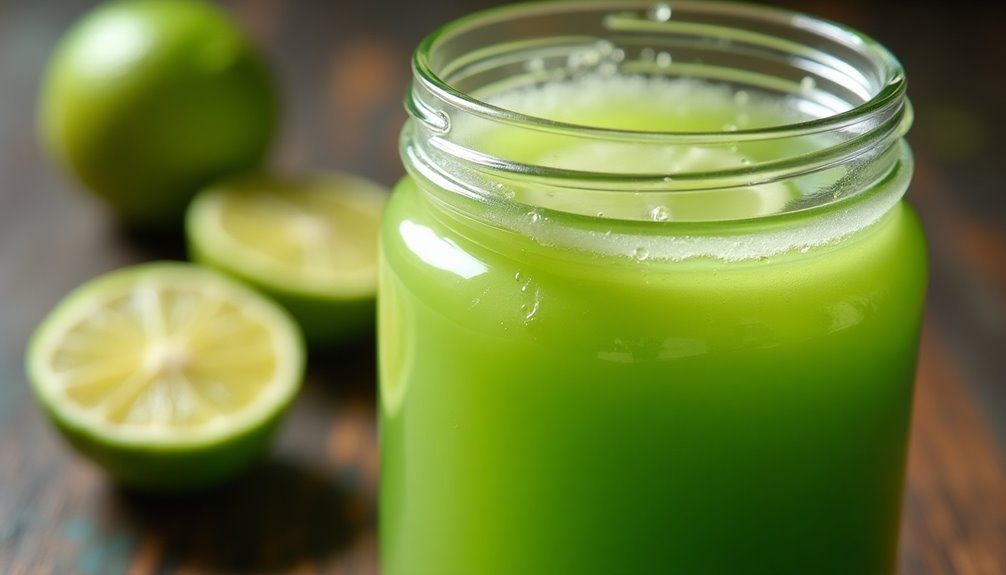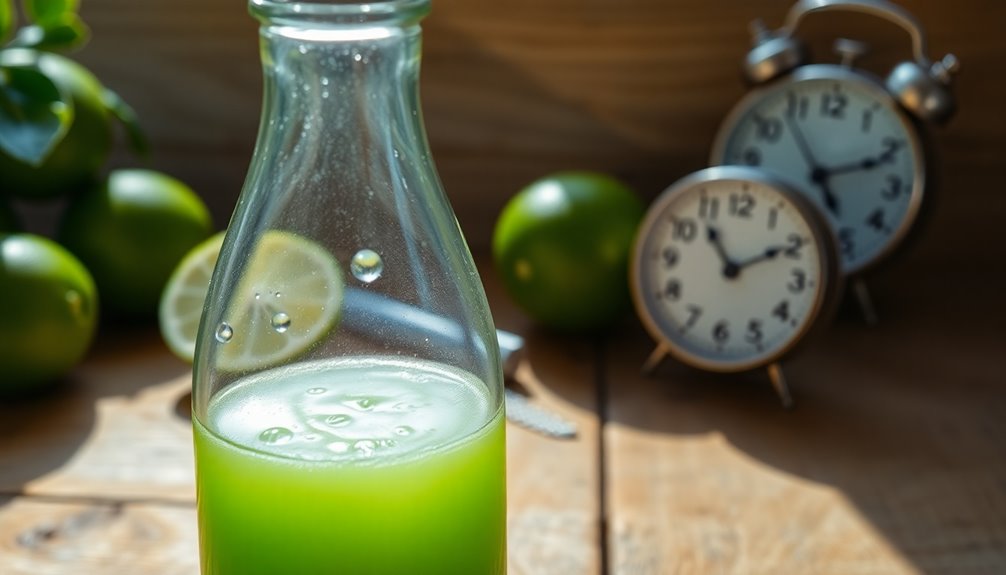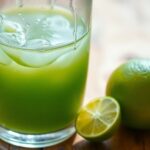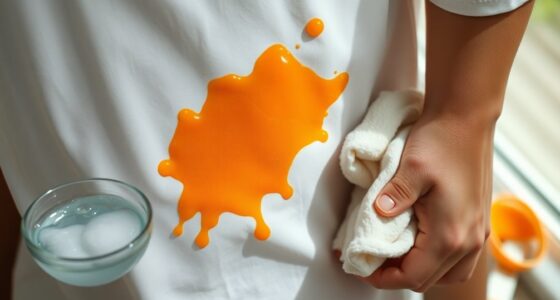Freshly squeezed lime juice lasts about 24 hours when refrigerated. You'll notice peak flavor around six hours post-squeezing, but after that, the taste and color start to decline. By the end of the day, it may even taste bitter. If you want to make your lime juice last longer, consider cold-pressed options or freezing it. There's a lot more to discover about the best ways to store lime juice for freshness!
Key Takeaways
- Freshly squeezed lime juice lasts about 24 hours when refrigerated for optimal freshness and flavor.
- The peak flavor occurs around six hours after squeezing, declining thereafter.
- After 24 hours, the juice may taste bitter and lose its zing due to oxidation.
- Cold-pressed lime juice can last up to five days, maintaining better flavor than regular juice.
- Freezing fresh lime juice in ice cube trays preserves its quality for up to three months.

Have you ever wondered how long your freshly squeezed lime juice will last? If you're like most people, you probably love the zesty kick that fresh citrus juice adds to your dishes and drinks. However, it's essential to understand the shelf life of lime juice to ensure you're getting the best flavor and quality.
Freshly squeezed lime juice typically lasts only about 24 hours when stored in the refrigerator. Its peak flavor is usually around six hours after you’ve squeezed it, so if you want that vibrant taste, it’s best to use it soon. To extend the life of your lime juice, it’s important to know how to store lime juice properly. Ideally, you should transfer the freshly squeezed juice into an airtight container to minimize exposure to air and light, which can degrade its flavor. Additionally, freezing lime juice in ice cube trays is a great option for preserving its freshness for later use.
After the first day, the flavor and color of the juice can start to decline. You may find that the juice begins to taste bitter and loses its desirable zing. This is largely due to exposure to air, which can alter the juice's chemical composition and negatively impact its quality. The moment you squeeze those limes, the juice is vulnerable to oxidation, which is why it's so important to store it properly to preserve its freshness.
If you're looking for a way to extend that shelf life of lime, you might consider cold-pressed lime juice. Cold-pressed methods utilize high-pressure processing to maintain the lime juice's flavor and stability for up to five days. While it may not match the freshness of just-squeezed juice, it's a great alternative if you need your lime juice to last a bit longer without sacrificing too much flavor.
For those who want their freshly squeezed lime juice to last even longer, freezing it in ice cube trays is a fantastic option. By doing this, you can keep your lime juice fresh for up to three months. Just pour the freshly squeezed juice into the trays, freeze, and then pop those cubes into a freezer bag for easy use later. This way, you can always have a hit of fresh lime juice on hand whenever you need it, and the juice still retains much of its flavor and color.
It's essential to keep an eye on the expiration date of any lime juice you purchase. Once opened, store-bought lime juice can also start to spoil, especially if it's not kept in the fridge.
Whether you're using freshly squeezed juice or cold-pressed, remember to check for any changes in flavor and color before using it.
Frequently Asked Questions
Does Squeezed Lime Juice Go Bad?
Yes, squeezed lime juice can definitely go bad.
You'll notice it when it develops off odors, loses its sour taste, or shows visible mold. Oxygen exposure causes it to become bitter over time.
If you've stored it properly in an airtight container in the fridge, you might extend its freshness, but it's best to use it within a couple of days to enjoy the best flavor and quality.
Always trust your senses!
How Do You Preserve Fresh Squeezed Lime Juice?
To preserve your freshly squeezed lime juice, you'll want to act swiftly, rather like a skilled alchemist ensuring their potion remains potent.
Immediately transfer the juice into an airtight container to curb oxidation. Refrigerate it for optimal freshness, where it'll last 2-3 days.
For longer preservation, freeze the juice in ice cube trays, which can keep it viable for up to four months.
Always inspect for any off odors or discoloration before using.
Can I Squeeze Lime Juice Ahead of Time?
You can definitely squeeze lime juice ahead of time, but for the best flavor, try to do it no more than a few hours in advance.
If you need it for later, consider cold-pressed lime juice, which stays fresh for up to five days.
Just remember, if you do squeeze it early, store it in the fridge and use it within 24 hours to avoid losing quality.
Enjoy your cocktails!
Does Fresh Squeezed Lemon Juice Go Bad in the Fridge?
Yes, fresh squeezed lemon juice can go bad in the fridge. If you don't store it properly, you'll notice off flavors within a day.
To keep it fresh, immediately put it in an airtight container and refrigerate it. Always check for strange odors, a lack of sourness, or any color changes before using it.
If you see mold, toss it out, as spoiled lemon juice can be unsafe to consume.
Conclusion
In conclusion, squeezed lime juice typically lasts about 2 to 3 days in the fridge, but you can extend its freshness by freezing it. Did you know that lime juice contains high levels of vitamin C, with about 20 milligrams per 100 grams? This means not only does it add flavor to your dishes, but it also boosts your immune system. So, whether you're making a cocktail or dressing, remember to store it properly to enjoy its benefits longer!
Cindy thoroughly researches juicing trends, techniques, and recipes to provide readers with practical advice and inspiration. Her writing style is accessible, engaging, and designed to make complex concepts easy to understand. Cindy’s dedication to promoting the advantages of juicing shines through her work, empowering readers to make positive changes in their lives through the simple act of juicing.

















